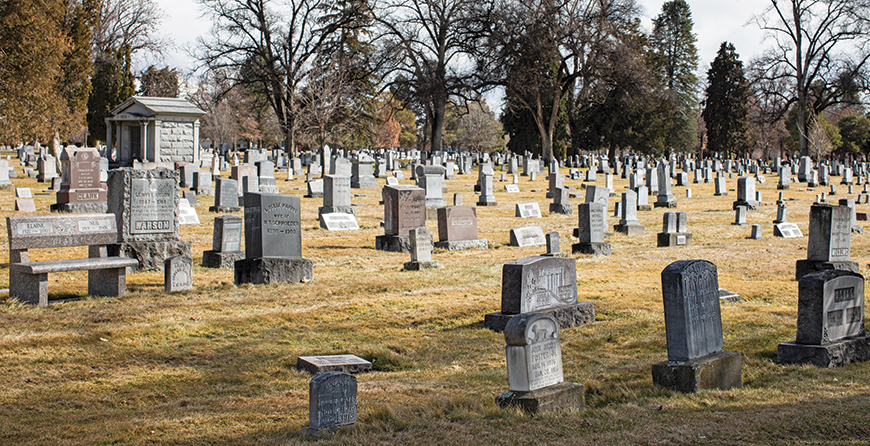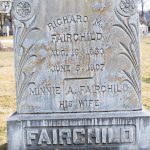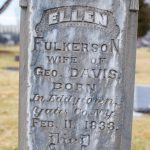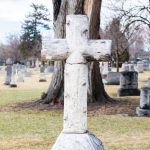Despite what many people have grown up believing about cemeteries—that they are morbid places reserved only for people who have loved ones interred within—the city of Boise’s three historic cemeteries—Morris Hill, Pioneer and Fort Boise—are open and welcoming to visitors who want to meander among the graves, sit under a tree and learn more about Boise’s rich past.
Like a museum, these cemeteries offer a place to see beautiful old sculptures, intricate carvings, and generations of history, all in a tranquil, park-like setting with no crowds.
Large, modern graveyards did not exist in America until about the 1830s. Up until then, people were buried in family plots, municipal burial grounds, and church graveyards. In the 20th century, cities and towns began designing cemeteries as park-like memorial lawns with more purposeful landscaping such as trees and ponds and winding roads.
The old saying, “Dead men tell no tales,” holds no credence when it comes to cemeteries. Tales are everywhere. They are told in the dates and sayings that are etched into a headstone, in the balloons and stuffed animals left on child’s grave, and the flowers resting atop a marker.
For those interested in cemeteries and their history, the city of Boise provides a downloadable walking tour for Morris Hill and Pioneer cemeteries to point visitors to some of the city’s most famous leaders and heroes, as well as infamous scoundrels from Boise’s past.
Morris Hill
Two miles up the road from the heart of downtown Boise sits Morris Hill Cemetery, a quiet, 60-acre spread of lush green lawn shaded by century-old trees that rustle with the activity of singing birds and skittering squirrels.
With more than 41,000 plots, Morris Hill is the largest of three historic cemeteries operated by the city of Boise’s Parks and Recreation department. The property was acquired by the city in 1882 when then-mayor James Pinney purchased it for $2,200 from William H. Ridenbaugh and Mrs. Lavinia L. Morris. When the cemetery opened, it offered a special funerary streetcar that would take bodies and mourners up the hill of the Boise Bench to the cemetery in a procession.
“Originally, Morris Hill was like a little city, laid out with various ethnic neighborhoods, as well as those for the more wealthy,” said Amy Pence-Brown an art and architectural historian and a death historian who has facilitated cemetery tours in Idaho for the past decade. The “neighborhoods” she refers to were grouped by religion and culture, such as the Saint John’s section, which was devoted to the burial of Boise’s Catholics; the Beth Israel Jewish section; the military sections, and the Chinese section, which is one of the most visible sections when approaching the cemetery. “Their native language is carved in the headstones, and their traditional funerary burner where mourners burn offerings so the dead can have riches in the afterlife are very prominent,” she said.
“Morris Hill is also the only city cemetery with several mausoleums. They are beautiful little architectural structures, many constructed by Tourtellotte & Hummel, the premier Idaho architects who designed 200 buildings in early Boise, including the Idaho State Capitol building,” she added.
The original Morris Hill burial book chronicles the first interment in March 1882 as that of a 15-year-old William Lindsay. Causes of death in the earliest burial records include such maladies as snow slide, consumption, falling trees, gunshot, gathering in the head, Bright’s disease, La Grippe, dropsy, and rickets.
The city’s cemetery walking tour identifies a number of interesting characters scattered throughout the cemetery from Boise’s past:
• John Jurko, buried 1926 after being hung for the murder of his mine claim partner, whom he shot in a dispute over his wife’s honor. Jurko’s attorney tried unsuccessfully to have his sentence commuted to life imprisonment arguing that “he was mentally unstable due to being kicked in the head by a mule when he was younger.”
• “Peg Leg” Annie Morrow, buried 1934, was a brothel owner during the Gold Rush era who lost her feet after being caught in a freak snowstorm.
• Harry Orchard, buried 1954, died after being jailed for 50 years for the killing of scores of men in mine labor violence, and for the dynamite slaying of Gov. Frank Steunenberg in 1905. He converted to Christianity and wrote the book, “Harry Orchard: The Man God Made Again,” a phrase that is etched on his grave marker.
• Idaho Gov. Moses Alexander, buried in 1932, was the first Jewish governor in the United States. He came to Boise a year after statehood and was twice elected governor and twice as mayor of Boise.
• Actor Reginald Owen, buried 1972, was best known for his role as the crotchety old Ebenezer Scrooge in the 1938 film version of Charles Dickens’ “A Christmas Carol.”
• Paul Revere, leader of the rock and roll band Paul Revere and the Raiders, was interred here in 2014. His granite marker is etched with a piano keyboard and the words, “He came. He rocked. He left.”
Speaking of grave markers, Pence-Brown said that you can recognize the various designs in certain time periods by knowing the trends. “The designs follow the trends of art and architectural history of the day,” she said. “Headstones from the early 1800s will use more of what we call macabre symbols before Christianity came into favor; things like skulls and crossbones representing death. In the late 1800s and early 1900s, the trend turned more to Victorian and religious symbolism, like the open or closed Bibles, God’s hand pointing down or up or reaching to lift the deceased through Heaven’s Gates.”
Some of Pence-Brown’s favorite symbols found in both Pioneer and Morris Hill cemeteries include the closed book, indicating the person’s story is complete, or an open book with a blank page, meaning that person’s story of life was cut short. Another prominent symbol is the lamb, indicating a child’s grave. “There is an entire section in Morris Hill for the Woodmen of the World Life Insurance Society, a fraternal business organization that provided grave markers to its members in the shape of stumps or logs, again representing the cutting down of a life, or cutting a life short,” she said.
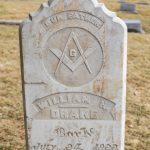
Headstones in the Pioneer Cemetery.
Pioneer Cemetery
The property now known as Pioneer Cemetery was first established as an unofficial public burial ground soon after the Boise area was settled in 1863. The first recorded burial in Pioneer Cemetery was Carrie Logan, who died on the Camas Prairie at the age of 5 years, 11 months and 5 days in August 1864.
Situated in the heart of the Warm Springs neighborhood, the 5-acre property was deeded to the city of Boise officially in 1920 and has been maintained by Boise Parks and Recreation since. Within the small, manicured cemetery are 1,796 marked graves, as well as many more that are unmarked. Because a large number of the very earliest markers were constructed of wood by friends and family members, an unknown number have disintegrated over the years. However, the existing markers read like a Who’s Who of historic Boise and include 11 former Boise mayors, eight Ada County sheriffs and five governors, in addition to other early movers and shakers:
• Corilla Robbins, buried 1927, was a pioneer woman who crossed the plains with her husband and four children by oxcart in 1876. She pioneered the women’s suffrage movement in Idaho and often cared for orphaned children in her own home. Her interest in new inventions and adventure prompted her to request, and receive, rides in the first automobile and airplane to arrive in Boise. She also received the first residential telephone in Boise.
• Milton Kelly, buried in 1892, was best known for the 17 years he was owner and editor of the Idaho Statesman; however, he also practiced law. In 1865, President Lincoln, in his last official act before his assassination, appointed Kelly to a four-year term as an associate justice of the Territorial Supreme Court. President Grant reappointed him in 1869. Described as “temperamental, vindictive and an unlikable man,” he was also reputed to have been fair and often courageous in his legal rulings.
• Mayor James Pinney, buried 1914, was sometimes called the “Father of Modern Boise.” A three-term mayor, he built fire stations, acquired Morris Hill Cemetery, extended city boundaries and was the impetus for donors to provide funding for the first 10 miles of sewer lines in Boise.
“Pioneer Cemetery is truly Boise’s only Victorian garden style cemetery, with monumental headstones and flowers and trees and meandering pathways for visitors,” said Pence-Brown. “It was originally created on the edge of the city and, today, sits squarely in the center of it.”
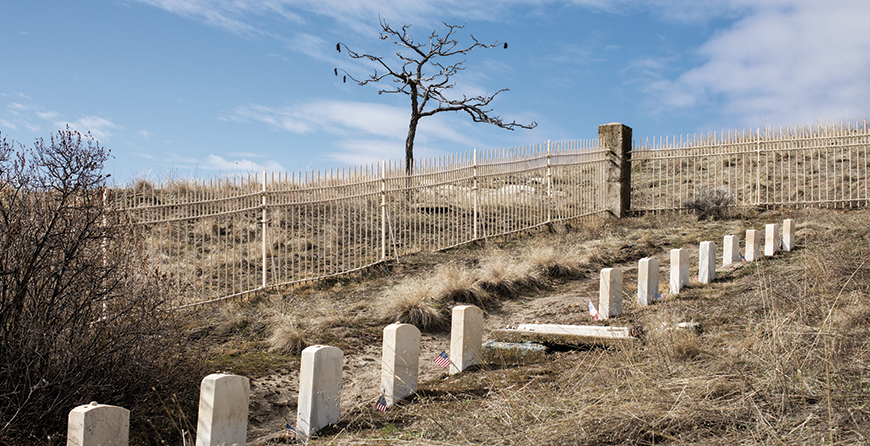
The Fort Boise Military Cemetery was deeded to the city with the stipulation that it be maintained in its natural condition as it was in the 1800s. Photo by Angie Smith.
Fort Boise Military Cemetery
A short drive up into the nearby foothills will take you to this lonely, rustic military cemetery, where veterans from the Mexican War, Indian Wars, Spanish-American War, and Civil War are buried.
On first inspection of the white tombstones standing alone and at attention in the desolate hills, among native, high desert plants, visitors may wonder if the buried had been abandoned and forgotten. But as Ken Reeves, facility manager with the city of Boise Parks and Recreation department explained, the stark beauty and isolated character is exactly how this cemetery is supposed to be.
Following World War II, the Department of Veterans Affairs deeded the cemetery to the city of Boise with the stipulation that the property would be perpetually maintained in its natural and historical condition, as it was in the 1800s.
“Fort Boise cemetery is preserved in its historical state and we maintain it to look like it would during the time it was an active cemetery,” said Reeves, adding that their role is to keep weeds down around the headstones and between the road and fence line, according to standards set by the Army Corps of Engineers. “It doesn’t give it a manicured look, and sometimes people think it looks abandoned, but we honor its historical importance and maintain the cemetery in its proper state.”
A fascinating piece of history about the 1.2-acre Fort Boise Cemetery is that, in 1906, heavy flooding in the area washed up many of its graves, an unnerving event for Boiseans at the time. The event inspired officers at the Boise Barracks to hire contractors to relocate the cemetery to its present location on higher ground. Records show that 166 graves were initially moved to the new location, but other graves were somehow left behind, and were discovered at the original site up until 1998. Those also were reinterred at the existing Fort Boise cemetery. Today, a total 252 enlisted men, officers, officers’ family members, and civilians rest in the Fort Boise Military Cemetery.
Cemeteries as Living Museums
“These three cemeteries are very special, and there is so much history and stories about the folks who are interred in them,” said Reeves. “We certainly welcome people to visit and enjoy the quiet and tranquility.”
Pence-Brown agreed: “Cemeteries are truly living museums, as funerary art trends have closely followed traditional art movements throughout American history. Cemeteries house the dead, but grave markers are fashioned by the living, who record on them not only the deceased’s pleasures, sorrows, and hopes for an afterlife, but also—more than they realize—document their history, ethnicity and culture.”
If You Go …
Morris Hill Cemetery
317 N. Latah,
Boise, ID 83702
(208) 608-7598
Walking Tour Information and Map
Pioneer Cemetery
460 E. Warm Springs Ave,
Boise, ID 83712
(208) 608-7598
Walking Tour Information and Map:
Fort Boise Military Cemetery
1101 Mountain Cove Rd.,
Boise ID 83702
(208) 608-7785 ex 3058

